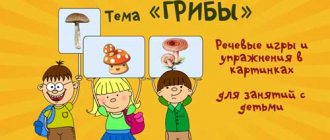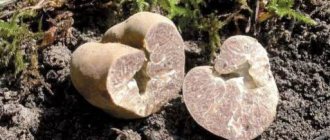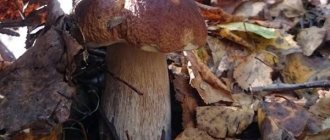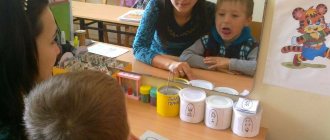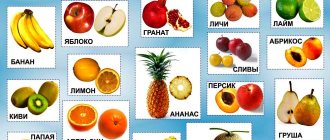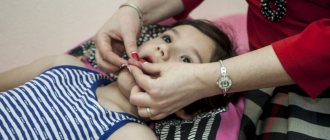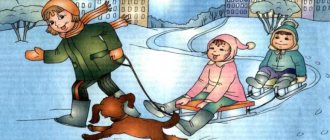Bright pictures with mushrooms, a story about each mushroom and coloring pages with mushrooms.
While exploring the wonderful world of nature, do not forget to tell your children in more detail about mushrooms - unique inhabitants of the natural world, occupying a middle position between the animal and plant kingdoms.
Children about mushrooms - mushroom pictures and stories
Story 4. Why are mushrooms needed? Who are mushrooms friends with?
Ask your child who and why mushrooms are useful. Yes. they are useful and necessary for people, animals, birds, and plants that grow next to them in the forest:
— Mushrooms are collected and eaten by people. We salt them, marinate them, cook mushroom soup from them, make mushroom caviar, bake pies with mushrooms and make many other delicious dishes from them.
— Animals also eat mushrooms. They feed on them in the summer and collect them and store them for the winter. Even mushrooms that are poisonous to humans can be beneficial to animals! For example, fly agaric is eaten by squirrels, slugs, and magpies. And a moose can swallow a whole fly agaric, and more than one! This is how he heals himself. For him, fly agaric is medicine.
— And also, mycelium is needed for the life of forest trees, shrubs, herbs and flowers. Mushrooms are true friends of trees! The mycelium grows together with the thin roots of the tree in the ground. As a result, the mushrooms receive the nutrition and beneficial substances they need from the trees, and the trees also receive useful substances from the mushrooms for their nutrition. Thanks to mushrooms, trees better absorb everything useful from their “food” and grow faster. This is how mushrooms and trees help each other throughout their lives! They are best friends and cannot live without each other!
For example, fly agaric helps pine, spruce, birch and other trees grow, and it also decorates the forest!
Mushrooms help process the remains of plants in the forest: they destroy stumps, fallen tree trunks, and fallen branches. These are forest orderlies who clean it.
Story 5. How do new mushrooms appear in the forest?
New mushrooms grow from the mycelium. But mushrooms have another secret to growth. As the mushroom grows, it produces spores.
Spores are very, very small dust-like particles - specks of dust. The wind carries them very, very far. There they fall to the ground, germinate and give rise to a new mycelium, and new mushrooms will soon appear from it.
Here’s how interesting it is said about this in the fairy tale - the forest dialogue by Eduard Shim “Mushroom Smoke”:
- My fathers, there is a fire!! My fathers, we are burning!.. From somewhere terrible smoke is pouring out!
— That one, from mushrooms. That's all.
- Oh, that's right! Smoke poured out of the bubble mushrooms! What is going on, my dears?!
- Nothing. The moose galloped. I trampled the puffball mushrooms.
- Why are they smoking?!
- Ugh! Yes because they are ripe! It's not smoke pouring out, it's mushroom spores, mushroom seeds, flying in the wind!
- Well, then go away, the smoke is thicker, there will be more mushrooms!
Story 6. How long do mushrooms live?
The life of a mushroom is very, very short! The mushroom is young for five days, on the sixth day the mushroom is usually fully ripe, and on the seventh day it is already... old :(. That’s how short their life is!
To make the child aware of this time period, show him Monday on the calendar. This is the day the mushroom appeared. Remember what you did with your child on Monday. Think about what you did on other days of the week and on Saturday. And at this time the mushroom is already fully ripe - in these few days it has already become quite an adult! Remember what you did on Sunday. How little time has passed! And the mushroom became an old man in just a week!
MOREL
Wrinkled, like old people, morels were born in the forest in the spring.
Avid mushroom pickers know that the first edible mushrooms in our forests, like snowdrops, appear in April. As soon as the snow melts, you can go for morels.
April is already here,
The snow in the forest has almost melted
And warmed the clearings...
You know, the morel is already ripe.
(E. Larskaya)
Morels are representatives of marsupial fungi. Their fruiting bodies are large, fleshy, up to 15 cm high. The cap is conical, ovoid, cellular, brown or brown in color, fused at the edges with the stem. In appearance, the wrinkled, lumpy caps of morels resemble shelled walnuts. Both the stem and the cap are hollow.
The mushroom on the leg bent like a hook,
But he stubbornly tries to reach up...
— It is popularly called “morel” —
That's what my laughing mother told me.
(A. Kropotin)
It has long been noticed that morels usually appear in those places of the forest where there was a fire three or four years ago. And in old fires they can appear every year. Another representative of marsupial fungi, the Stochki, has a cap that is often shapeless, wavy-folded or brain-shaped, partially fused along the edge with the stalk. The leg is thick, hollow, light. For a long time, the strings were considered conditionally edible; later, the toxin gyromitrin was discovered in them, which is not destroyed during cooking and accumulates in the body. Gyromitrin disappears when dried, so it is better not to eat the stitches fresh.
Unlike strings, morels can be eaten both after drying and fresh, after boiling for 10-15 minutes. And in America, morels are generally called the “king of mushrooms” and many delicacies are prepared from them. The main dish at the annual conventions of American mushroom scientists is pancakes with morels.
But of course, mushrooms such as morels and strings must be treated with caution. Numerous cases of mushroom poisoning were reported by ancient Greek and Roman historians. There were also titled persons among the “mushroom” victims. For example, the Roman emperor Claudius. His wife Agrippina knew a lot about mushrooms. Claudius somehow quarreled with her, for which he paid.
Our ancestors knew about the hallucinogenic properties of some mushrooms. By eating them, people received relaxation, but often died from an overdose. Shamans often put themselves into a trance using mushrooms. The Vikings used fly agarics as doping before the battle.
Story 7. Are there harmful mushrooms?
There are edible mushrooms, and there are poisonous ones. Therefore, in the forest, children must always ask adults if they can pick up a mushroom found in the forest or in the park. If you don’t know the mushroom, then it’s better to leave it in the forest and not take it.
How to tell children about poisonous mushrooms? It is very clearly explained to kids what poisonous mushrooms are and what they are like in the Shishkina School program on the topic “Poisonous Mushrooms.” Watch it with the kids.
Poisonous mushrooms: video for children
In this video, the child will see poisonous mushrooms: he will learn what toadstool, fly agaric, real and false chanterelles are (he will learn how to distinguish an edible chanterelle from a poisonous mushroom), what false mushrooms are and what is their difference from real honey mushrooms. And also learns the rules of the mushroom picker.
PORCINI
And under the old pine tree, where the old man stump bent,
Surrounded by his family
The first boletus was found.
(V. Rozhdestvensky)
Based on taste and nutritional value, edible mushrooms are usually divided into four groups. The first includes porcini mushrooms, saffron milk caps and real milk mushrooms. The second includes boletus, boletus, boletus, champignons, and boletus. The third includes black milk mushrooms, fly mushrooms, chanterelles, morels, and autumn honey mushrooms. The fourth includes umbrella mushrooms, brittle types of russula, summer honey mushrooms, oyster mushrooms, talkers.
This division is arbitrary; each mushroom picker has his own preferences. Tastes also differ among different peoples. In Russia, milk mushrooms are considered valuable mushrooms, but in Western European countries they are considered inedible. Some peoples prefer dung beetles and umbrella mushrooms, while others consider them inedible and do not collect them.
The highest quality of all mushrooms is rightly called the porcini mushroom, or boletus. Many mushroom pickers only consider their trip to the forest successful if there is at least one white mushroom in their basket. This mushroom is called porcini because, unlike other tubular mushrooms, its flesh does not change color when broken and remains white both after cooking and after drying.
The cap of the porcini mushroom is convex, can reach 25 cm in diameter, its color varies from whitish to dark brown, depending on the forest in which the mushroom grew. The lower surface of the cap is spongy, with well-defined tubes, initially white, turning yellow with age.
The stem of the porcini mushroom is thick, sometimes up to 10 cm thick and about 17 cm long. In young mushrooms, the stem is tuberous, in mature ones it is cylindrical, with a light mesh pattern in the upper part. The weight of the fruiting body can reach 10 kg.
The porcini mushroom is found in deciduous, coniferous and mixed forests. It is most often adjacent to spruce, birch, and oak. Porcini mushrooms are very nutritious. There is even a saying: “Boron mushroom is better than any meat.” The mushroom is eaten fried, dried, or pickled. In folk medicine, an extract from porcini mushroom is used. The porcini mushroom has twins: the gall mushroom and the oak mushroom.
MYSTERY
Lukashka is standing in a white shirt.
And the hat is wearing chocolate color.
(Porcini)
Story 8. What are “deciduous mushrooms” and why are they called that?
Why are mushrooms called “deciduous” mushrooms? “Leaf-fallen” - from the word “leaf-fallen”. What is “leaf fall”? Yes, leaves are falling = leaf fall. This means that such mushrooms grow during leaf fall. This happens in October. These are boletuses, aspen mushrooms, saffron milk caps, milk mushrooms, volushki and others.
Discuss with your child where you should look for mushrooms in the fall during leaf fall - in dark, cold forests in the shade or in the sun? Yes, you need to look for them where it’s warm, where the sun is warm. They hide under fallen leaves. You won't find them in a cold forest.
Educational fairy tales and stories about mushrooms for children
We all know that boletus grows under birch trees, and boletus under aspens. And why? From N. Pavlova's fairy tale, children will learn why each mushroom has its own plants - friends and its own “mushroom address” in the forest.
N. Pavlova's fairy tales are amazing. She is a doctor of biological sciences by profession and knows the life of plants and animals very well. And her second profession is a children's writer. Therefore, her fairy tales are interesting, very educational, and beloved by children!
N. Pavlova “Two tales about mushrooms”
A little girl went into the forest to pick mushrooms. I went up to the edge and let's show off:
- You, Les, better not hide mushrooms from me! I'll still fill my cart full. I know everything, all your secrets!
- Don't boast! - the forest made a noise. - Don't brag! Where is everyone?
“But you’ll see,” the girl said and went to look for mushrooms.
In the fine grass, between the birch trees, boletus mushrooms grew: gray, soft caps, stems with black shag.
In a young aspen grove gathered thick, strong little aspen boletuses in tightly pulled orange caps.
And in the twilight, under the fir trees, among the rotten pine needles, the girl found short saffron milk caps: red, greenish, striped, and in the middle of the cap there was a dimple, as if an animal had pressed it with its paw.
The girl picked up a basket full of mushrooms, and even with the top on! She came out to the edge and said:
- Do you see, Les, how many different mushrooms I picked? This means I understand where to look for them. It was not for nothing that she boasted that I knew all your secrets.
- Where is everyone? - Les made a noise. “I have more secrets than leaves on the trees.” And what do you know? You don’t even know why boletus grows only under birches, boletuses - under aspens, saffron milk caps - under fir trees and pine trees.
“Here comes the house,” answered the girl. But she said it just like that, out of stubbornness.
“You don’t know this, you don’t know,” Les made a noise, “telling this would be a fairy tale!”
“I know what a fairy tale,” the girl stubbornly said. “Wait a little, I’ll remember it and tell you myself.”
She sat on a stump, thought, and then began to tell.
There used to be a time when mushrooms did not stand in one place, but ran throughout the forest, danced, stood upside down, and played mischief. Previously, everyone in the forest knew how to dance. Only Bear couldn't do it. And he was the most important boss.
Once in the forest they celebrated the birthday of a hundred-year-old tree. Everyone danced, and the Bear - the one in charge - sat like a tree stump. He felt offended and decided to learn to dance. He chose a clearing for himself and began to exercise there. But he, of course, did not want to be seen, he was embarrassed, and therefore gave the order:
- No one should ever appear in my clearing.
And mushrooms loved this clearing very much. And they did not obey the order. They waylaid him when the Bear lay down to rest, left Toadstool to guard him, and they ran off to the clearing to play.
The bear woke up, saw Toadstool in front of his nose and shouted:
- Why are you hanging around here?
And she answers:
“All the mushrooms ran away to your clearing, and they left me on guard.”
The bear roared, jumped up, slammed Toadstool and rushed into the clearing.
And the mushrooms played magic wand there. They hid somewhere. The mushroom with a red cap hid under the Aspen, the red-haired one hid under the Christmas tree, and the long-legged one with black shags hid under the Birch.
And the Bear will jump out and scream - Roar! Gotcha, mushrooms! Gotcha!
Out of fear, the mushrooms all grew into place.
Here Birch lowered her leaves and covered her fungus with them. The aspen dropped a round leaf directly onto the cap of its mushroom. And the tree scooped up dry needles with its paw towards Ryzhik.
Bear looked for mushrooms, but didn’t find any.
Since then, those mushrooms that were hiding under the trees have been growing, each under their own tree. They remember how it saved him. And now these mushrooms are called Boletus and Boletus. And Ryzhik remained Ryzhik, because he was red. That's the whole fairy tale!
- You came up with this idea! - Les made a noise. - It’s a good fairy tale, but there’s not a bit of truth in it. And listen to my true story.
Once upon a time there were roots of the forest underground. Not alone - they lived in families: the Birches - near the Birch, the Osinovs - near the Aspen, the Spruce - near the Christmas tree.
And lo and behold, out of nowhere, homeless Roots appeared nearby. Marvelous Roots! The thinnest web is thinner. They rummage through rotten leaves and forest waste, and whatever edible they find there, they eat and put aside for storage.
And the Birch Roots stretched out nearby, looking and envying.
“We,” they say, “can’t get anything out of the waste, out of the rot.” And Marvelous Roots responded: “You envy us, but they themselves have more good than ours.”
And they guessed right! For nothing that a cobweb is a cobweb. The Birch Roots received great help from their own Birch Leaves. The leaves sent food down the trunk from top to bottom. And what they used to prepare this food from, you have to ask them themselves. Divo-Koreshki is rich in one thing. Birch Roots - to others.
And they decided to be friends.
Marvelous Roots clung to the Berezovs and entwined them around them. And the Birch Roots do not remain in debt: whatever they get, they share with their comrades.
Since then they have lived inseparably. It’s good for both. Miracle Roots is growing wider and wider, all reserves are being accumulated. And Birch grows and gets stronger.
Summer is in the middle, Birch Roots boast:
“Our Birch’s earrings are ruffled and the seeds are flying!”
And Miracle Roots answer:
- That's how it is! Seeds! So it’s time for us to get down to business.
No sooner said than done: the little nodules jumped up on the Divo-Roots. At first they are small. But how they began to grow! The Birch Roots didn’t even have time to say anything, but they had already broken through the ground. And they turned around in freedom, under Berezka, like young mushrooms. Legs with black shag. The hats are brown. And from under the caps mushroom seeds-spores fall out. The wind mixed them with birch seeds and scattered them throughout the forest.
This is how the mushroom became related to Birch. And since then he has been inseparable from her. For this they call him Boletus.
That's my whole fairy tale! It's about Boletus, but it's also about Ryzhik and Boletus. Only Ryzhik took a fancy to two trees: the Fir-tree and the Pine.
“This is not a funny fairy tale, but a very amazing one,” said the girl. - Just think, some kind of baby fungus - and suddenly it feeds the giant tree!
A. Lopatina's story - for younger schoolchildren. Can mushrooms really be grown in the garden? Should I give up wild mushrooms? Why have many beneficial mushrooms now become harmful? These questions are discussed in the story by the grandfather with his granddaughters.
A. Lopatina. Introduction to mushrooms
At the beginning of July it rained for a whole week. Anyuta and Mashenka became depressed. They missed the forest. Grandmother let them go for a walk in the yard, but as soon as the girls got wet, she immediately called them home.
Porfiry the cat said when the girls called him for a walk:
- Why would you want to get wet in the rain? I’d rather sit at home and write a fairy tale.
“I also think that a soft sofa is a more suitable place for cats than damp grass,” Andreika chimed in.
Grandfather, returning from the forest in a wet raincoat, laughing, said:
— July rains nourish the earth and help it grow crops. Don’t worry, we’ll go to the forest to pick mushrooms soon.
Alice, shaking herself so that wet dust flew in all directions, said:
“The russula have already started to climb, and in the aspen grove two small boletuses with red caps popped up, but I left them, let them grow up.”
Anyuta and Mashenka were looking forward to their grandfather taking them mushroom picking. Especially after he once brought a whole basket of young mushrooms. Taking out the strong mushrooms with gray legs and smooth brown caps from the basket, he said to the girls:
- Well, guess the riddle: We met namesakes in the grove near the birch tree.
“I know,” Anyuta exclaimed, “these are boletus trees, they grow under birch trees, and aspen boletuses grow under aspen trees.” They look like boletus mushrooms, but their caps are red. There are also boletus mushrooms, they grow in forests, and multi-colored russula grow everywhere.
- Yes, you know our mushroom literacy! - Grandfather was surprised and, taking out a whole heap of yellow-red lamellar mushrooms from the basket, said:
- Since all the mushrooms are familiar to you, help me find the right word: Golden... Very friendly sisters, They wear red berets, They bring autumn to the forest in the summer.
The girls were silent in embarrassment.
“This poem is about chanterelles: they grow up in a huge family and turn golden in the grass like autumn leaves,” explained the all-knowing Porfiry.
Anyuta said offendedly:
- Grandfather, we only studied some mushrooms at school. The teacher told us that many mushrooms are poisonous and should not be eaten. She also said that now even good mushrooms can be poisoned, and it is better not to pick them at all.
“The teacher told you correctly that you can’t eat poisonous mushrooms and that now many good mushrooms are becoming harmful to humans. Factories emit all sorts of waste into the atmosphere, so various harmful substances settle in forests, especially near large cities, and mushrooms absorb them. But there are a lot of good mushrooms! You just need to make friends with them, then they themselves will run out to meet you when you come to the forest.
- Oh, what a wonderful fungus, strong, plump, in a velvet light brown cap! - Mashenka exclaimed, sticking her nose into the basket.
- Mashenka, the white one jumped out ahead of time. They usually appear in July. They say about him: A strong little boletus came out, and everyone who sees it will bow down.
- Grandfather, why is the boletus called white if it has a brown cap? - Mashenka asked.
— Its flesh is white, tasty and fragrant. In boletuses, for example, the flesh turns blue if you cut it, but in white ones the flesh does not darken either when cutting, or when boiling, or when drying. This mushroom has long been considered by people as one of the most nutritious. I have a professor friend who studies mushrooms. So he told me that in boletus mushrooms scientists have found the twenty most important amino acids for humans, as well as many vitamins and minerals. It’s not for nothing that these mushrooms are called forest meat, because they contain even more proteins than meat.
“Grandfather, the teacher told us that in the future people will grow all the mushrooms in their gardens and buy them in the store,” said Anyuta, and Mishenka added:
— Mom bought us mushrooms at the store - white champignons and gray oyster mushrooms, very tasty. Oyster mushrooms have caps that look like ears, and they grow together as if they were one mushroom.
— Your teacher is right, but only forest mushrooms give people the healing properties of the forest and its best aromas. A person cannot grow many mushrooms in his garden: they cannot live without trees and forests. The mycelium with the trees, like inseparable brothers, intertwined their roots and feed each other. And there aren’t many poisonous mushrooms, people just don’t know much about mushrooms. Every mushroom is useful in some way. However, if you go into the forest, the mushrooms themselves will tell you everything about themselves.
I really love the story “Fly Agaric”. How vividly and expressively this mushroom is described in it: it is compared to a gnome in a red cap and lace pantaloons! And it is said that even a mushroom that is poisonous to humans is useful to the inhabitants of the forest as a medicine!
N. Sladkov Fly agaric
The handsome fly agaric looks kinder than Little Red Riding Hood and is more harmless than a ladybug. He also looks like a cheerful gnome in a red beaded cap and lace pantaloons: he’s about to move, bow to the waist and say something good. And in fact, although it is poisonous and inedible, it is not entirely bad: many forest inhabitants even eat it and do not get sick. Moose sometimes chew, magpies peck, even squirrels, which is why they know about mushrooms, and even those sometimes dry fly agaric mushrooms for the winter. In small proportions, fly agaric, like snake venom, does not poison, but heals. And the animals and birds know this. Now you know too. But never - never! - do not try to treat yourself with fly agaric. A fly agaric is still a fly agaric - it can kill you!
After reading the story, look again at the picture of the fly agaric (you will find it in the set of pictures about mushrooms at the link above) and discuss with your child: - how is the fly agaric similar to a gnome? where is his red riding hood? Why is the cap in the story called “beaded”? (decorated with white beads - show the child large white beads and find the beads on the fly agaric's cap) And where does the fly agaric have white pants - pantaloons with lace? - How is fly agaric useful? - Is it possible for people to pick fly agaric? Why?
And another story about mushrooms - fly agaric mushrooms by N. Sladkov “Round Dance of Mushrooms”. Read a fragment of the story to your child and discuss with him:
- What do fly agaric mushrooms look like? what does their foot look like? their hat? - how do they “stand with their hands akimbo” (show this pose) - what are the fly agarics waiting for? — how do fly agarics dance on their white legs? (come up with a few movements together to a dance or round dance melody) - do they dance quickly? - “White legs will flash” - what does this mean? When do they say: “only the heels began to sparkle”, “only the legs began to sparkle”? Has it ever happened to you that you moved so fast that only your legs flashed? When? Share your life stories too.
N. Sladkov. Round dance of mushrooms
The mushroom picker does not take fly agarics, but he is happy with fly agarics: if fly agarics go, so will white ones. And fly agarics are a delight to the eye, even though they are inedible and poisonous. They stand akimbo on white legs, in lace pantaloons, in red clown hats - if you don’t want to, you’ll fall in love with them. And if you come across a fly agaric round dance, it’s time to be dumbfounded: a dozen red fellows stood in a circle and prepared to dance! Now - one, two! - someone will clap their hands and - three, four! - the round dance will begin! Faster and faster - like a colorful festive carousel. White legs flash and dry leaves rustle. You stand and wait. And the fly agarics stand and wait. They are waiting for you to finally figure it out and leave. So that you can start your mushroom dance without interference or prying eyes. Stomping the white mushroom legs, waving the red mushroom caps. Just like in the old days..."
In the next fairy tale, kids will get acquainted with an interesting mushroom that grows on stumps and trees - honey fungus.
V. Zotov. Honey fungus Autumn
“Mommy, look, the mushrooms don’t have enough soil,” the Little Fox was surprised. “They even climbed trees!” “You still don’t know much,” the Fox smiled. — Autumn honey fungus often grows on tree trunks. Sometimes in the fall, yellow-brown caps, which are the size of a small saucer, hang in clusters so high that they cannot be reached. “And that family over there sat right on a rotten stump.” — The kid pointed to a stump near the tree. - Mom, are all these mushrooms edible? — Of course, Autumn Honey fungus is very tasty. No one passes by him. Everyone puts it in the basket, everyone wants to try this mushroom. And to distinguish it from the poisonous false foam, you need to look at the plates from below. In edible honey mushrooms they are always light - white, cream or yellowish.
Funny poems about mushrooms
Funny poems about mushrooms are fun to read together online.
76.Only red fly agaric
Only the red fly agaric proudly climbs onto the hillock. What a dandy, what a dandy! And on the leg there is a white bow.
Author: Simbirskaya Yu.
***
77. The gnome stomped along the path
The gnome was stomping along the path, A basket was wandering nearby. Borovik meets them. He boldly goes into the basket - jump! Russulas and chanterelles And small little hornets, They gathered in the clearing And lay down in a basket! The basket is full to the brim, with rowan berries on top! Goodbye, mushroom forest! It's time for us to go home.
Author: Elovikova D.
***
78.Why butterfly mushrooms
Why are butter mushrooms, picky playful little ones, only playing hide and seek with me and not hiding from grandfather? They jump into a basket with their grandfather From under the grass, from under a hummock. I have only needles and dried leaves! What are these strange habits? I’ll figure out their secret, After all, playing hide and seek at home, I hide better than anyone in the world!
Author: Dolgikh E.
***
79. My friends and I went to the forest
My friends and I went into the forest, We found a lot of mushrooms there, White and red chanterelles, And voluptuous little sisters. The fly agarics nodded to us, We didn’t take them into baskets, We don’t need them like that, They’re poisonous.
Author: Konkov I.
***
80. We are with the whole family on Saturday
On Saturday, the whole family went into the forest to pick mushrooms, took the poodle with us, and walked about five kilometers. And we found enough mushrooms for three wallets without difficulty, Enough for the soup and for pickling, And we’ll dry it, as always. There is steam in the kitchen in clouds, There is a row of pots on the stove, The table is covered with mushrooms, We wash and cook everything. Heaps of saffron milk caps, boletus, boletuses are here, russula and honey mushrooms, milk mushrooms are waiting in line. The porcini mushroom will go for drying, Three low ones have been attached, And toy mushrooms are hanging - Admire, look. And the chanterelles for frying - We'll have dinner now, put the rest in jars, and roll it up for reserve. And during the winter cold Let's prepare mushroom soup, For lunch or dinner - Let's remember the spirit of the forest again.
Author: Vargus N.
***
81. Mushroom under the tree, boletus
A mushroom under the tree, a boletus lifts its collar, cowers near the hummocks, cowers, worries. He wants to grumble, He gathered his children, He mutters to them: “On Saturdays, Children hide from people, Whoever is covered with leaves will remain alive!”
Author: Kalganova T.
***
82.Oh, hard fate
Oh, the hard fate of the edible mushroom! From the first days I play hide and seek Because life is a struggle. There are evil worms everywhere and mushroom pickers with knives. The chances of growing up, believe me, are not particularly great. The squirrel is looking, the hedgehog is prowling, And you can’t tell them: “Don’t touch”! When they find it, they will eat it, of course... Animals! What can you get from such people? But most of all, oddly enough, I am afraid of Ivan. No matter how small he looks, he can see the mushroom everywhere! Oh! Well... Goodbye, bros... Ivaaaaaaaaaaaaaaaaaaaaaaaaaaaaaaaaaying is approaching....
Author: L. Ulanova
***
83.Yes, it’s not easy to look for mushrooms
Yes, it’s not easy to look for mushrooms - they are small. They hide under the trees, covered with needles.
Author: Fadeeva N.
***
84. Amanita
It’s not worth bending your back over him, he won’t decorate the basket. People have known for a long time: The fly agaric is inedible!
Author: Shulzhik V.
***
85. Russula
The rain rushed over the clearing, To the russula He was captured... And the insects fly in a hurry To get water to the russula.
Author: Shulzhik V.
***
86.Ryzhik
Under the pine tree, in the red needles, don’t look for the saffron milk cap in the spring. Ryzhik Ryzhik Ryzhik for good reason: Ryzhik - Messenger of September.
Author: Musatov V.
***
87. Boletus
This mushroom is my favorite, very slender and straight. Look how the Hat burns with a bright flame! In the clearing he stands, Like a soldier under a banner.
Author: Serova E.
***
88. Oil cans
The foolish little oil cans are swaddled in swaddling clothes, And the old-time oil cans wear all their collars.
Author: Serova E.
***
89. Chanterelles
These tiny foxes are very friendly sisters: Where there is one, look around - and you will see ten of them. Like yellow buttons, they stuck into the moss near the path.
Author: Serova E.
***
Signs and sayings about mushrooms
- Late mushroom - late snow.
- Where one oiler was born, others fled side by side.
- The panicles of oats have ripened - honey mushrooms have grown in the forest.
- If there are few mushrooms produced, then the winter will be snowy and harsh.
- Those who love to bow to the earth will not be left without mushrooms.
- Those who get up early put mushrooms in the car.
- When it rains in the evening, expect mushrooms in the morning.
- When it’s hot and damp, mushrooms gather under the trees; when it’s damp and damp, they scatter into the clearings.
- Rain in the evening - expect mushrooms in the morning.
- How many rains - so many milk mushrooms.
- If there is a steamy fog over the forest, go mushroom hunting.
- Heavy dew - to fertility, and frequent fogs - to the harvest of mushrooms.
- If there are waves in the forest, then expect the milk mushrooms to appear soon.
- If the rye starts to sprout, white ones with boletus mushrooms also begin to appear.
- Where there is a red fly agaric, there is a white mushroom sitting nearby.
- If the night at Christmas is starry, and so is the night at Epiphany, then in the summer there will be a lot of berries and mushrooms.
Edible species and their descriptions with photos
The most common edible types of paths are the following mushrooms:
- Yellow-brown.
- Grey.
- Pigeon.
Yellow-brown row
Yellow-brown rows have convex caps of a yellow-brown hue with a dry velvety surface. The caps have reddish scales. The leg is hollow, curved, thickened towards the base. Its color is identical to the color of the cap. The leg is densely covered with scales. The plates have a bright lemon tint.
Gray rows are distinguished by ash caps with a purple tint. In the center there is a pronounced tubercle one tone darker than the color of the cap. The surface is slippery and sticky. The stalk is fibrous, thickened at the base. It has a white or yellowish color and is completely covered with a powdery coating. The plates are slightly tortuous and white.
The pigeon track has a white, fleshy cap with heavily cracked edges. It is presented in a hemispherical shape. The surface is wet and sticky. The leg is curved, white. Sometimes it has a greenish tint at the base. The plates are white and wide.
Pigeon path
More games, exercises, pictures, riddles on the topic “Mushrooms” for children
You will find more materials for games and activities with children on the topic “Mushrooms” in the articles on the site:
— Riddles about mushrooms: educational tasks for children, 95 riddles about mushrooms with pictures and answers, how to choose the right riddle according to the child’s age, how to come up with a riddle about a mushroom together with children.
— Pictures “Mushrooms”: for games and activities to develop speech and familiarize yourself with the world around you.
— Theme “Mushrooms”: speech games and exercises for children.
